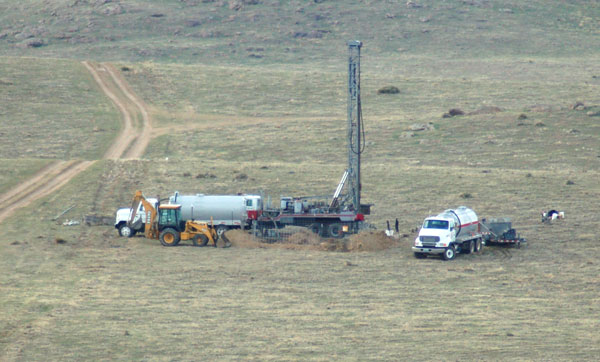Report on proposed aquifer pump test on Section 33
Posted May 16, 2009, Updated June 28, 2009
The photo below shows a Powertech drill rig on Section 33, north of Weld County Road 110 between county roads 17 and 19. The site is about 7 miles northeast of Wellington. The drilling is authorized under a state Notice of Intent to Conduct Prospecting (P-2008-043). According to Powertech, the wells being drilled on Section 33 will be used to conduct an aquifer pump test to collect data for mine permit applications.
During the proposed pump test, water would be continuously pumped from the target aquifer to the surface for up to six days. About 170,000 gallons of water would be removed and stored for later disposal. Water levels in observation wells would be measured for drawdown, providing data on how much water can be transmitted horizontally through the aquifer, labeled the A2 Sand by Powertech. Observation wells in overlying and underlying aquifers would be monitored to determine whether the ore-bearing aquifer is confined or whether vertical leakage during mining is possible.

Pump tests are required to determine if in-situ leach mining is economically feasible and whether ISL mining is likely to contaminate other aquifers. The data are also used to design optimum wellfield configurations.
The purpose of the tanker trucks in the photo is unknown, although they may contain fluid for hydraulic fracturing of the wells. A hydrofracturing truck from The Well Improvement Company Inc., a Fort Collins firm, was seen leaving Section 33 on the day the photo was taken (May 5, 2009). Hydraulic fracturing is a form of "well stimulation" commonly used in the oil and gas industry to increase fluid flow into wells. A fracture fluid is injected under extremely high pressure to create or expand cracks in the underground rock formation. Sand or ceramic beads are added to the fracture fluid to prop open the resulting cracks. These "proppants" have a higher permeability than the surrounding rock formation and provide a conduit for fluids to flow to or from the well.
It is unclear whether Powertech is conducting hydrofracturing on these wells since little public information is available on the proposed pump test and related drilling.
(Note: On May 29, 2009, I received an email from a Wyoming driller who observed that the activity in the photo above could not include hydraulic fracturing because the well was still being drilled and because several more water trucks would be required to provide the required volume of fracture fluid. It should be noted that there are other Powertech wells on this section of land, and also that the Well Improvement Company Inc. has developed a "scaled-down version of the oil field techniques" that uses only 2,000 gallons of fluid.)
In fact, the company has not sought or received approval from the Colorado Division of Reclamation, Mining and Safety (DRMS) for the pump test. Only a brief discussion of the proposed pump test was included in Powertech's March 4, 2009 submittal to the DRMS requesting approval of a second modification to NOI P-2008-043.
In its letter, Powertech simply announced that it would be conducting a pump test. The purpose of the submittal was to seek approval for disposal of the pump test water in an unlined infiltration pit. Since the pump test would be conducted in a part of the aquifer containing uranium deposits, the wastewater would have elevated levels of uranium and radium.
Because this wastewater might migrate into the shallow, higher-quality Laramie Formation aquifer, there are concerns about this disposal method. Concerned landowners and members of the public as well as Weld County officials submitted comments to the DRMS questioning the wisdom of this proposal. In response, the DRMS requested additional technical information from Powertech and directed the company to respond to the concerns of landowners and county officials.
Powertech's reaction was to withdraw the infiltration pit proposal and complain that the DRMS is not authorized to accept and respond to comments by local governments and the public regarding prospecting activities.
Powertech is now proposing that it would store the pump test wastewater in metal tanks and then inject it back into the A2 formation aquifer. Under federal regulations, Powertech would have to obtain a Class V Underground Injection Control permit from the U.S. Environmental Protection Agency.
According to Valois Shea from the EPA's Region 8 office in Denver, Powertech has already submitted a Class V permit application. If the application is deemed complete, the EPA will review the application and prepare a draft permit (if it chooses not to deny.) The draft permit and a "Statement of Basis" will be released and public notice will be given. After a 30-day public comment period, a public hearing will be held. The hearing may take place in Nunn, Wellington, or Greeley, and could happen as early as July.
The EPA must review and respond to public comments. If the application is approved, a final permit is drafted and issued along with the administrative record. The permit is effective in 30 days unless appealed and stayed.
Presumably, Powertech must still submit an application to the DRMS for an NOI modification for injection of the wastewater. Whether the DRMS must approve the pump test itself is an open question.
JW